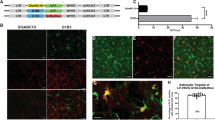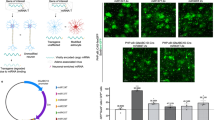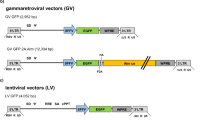Abstract
Novel gene-based therapies for disease will depend in many cases on long-term persistent transgene expression. To develop gene therapy strategies for Friedreich's ataxia (FRDA), we have examined the persistence of transgene expression in the brain in vivo provided by the entire 135 kb FXN genomic DNA locus delivered as an infectious bacterial artificial chromosome (iBAC) herpes simplex virus type 1 (HSV-1)-based vector injected in the adult mouse cerebellum. We constructed genomic DNA-reporter fusion vectors carrying a complete 135 kb FXN genomic locus with an insertion of the Escherichia coli lacZ gene at the ATG start codon (iBAC-FXN-lacZ). SHSY5Y human neuroblastoma cells transduced by iBAC-FXN-lacZ showed high efficiency of vector delivery and LacZ expression. Direct intracranial injection of iBAC-FXN-lacZ into the adult mouse cerebellum resulted in a large number of easily detectable transduced cells, with LacZ expression driven by the FXN genomic locus, which persisted for at least 75 days. Green fluorescent protein expression driven from the same vector but by the strong HSV-1 IE4/5 promoter was transient. Our data demonstrate for the first time sustained transgene expression in vivo by infectious delivery of a genomic DNA locus >100 kb in size. Such an approach may be suitable for gene rescue strategies in neurological disease, such as FRDA.
This is a preview of subscription content, access via your institution
Access options
Subscribe to this journal
Receive 12 print issues and online access
$259.00 per year
only $21.58 per issue
Buy this article
- Purchase on Springer Link
- Instant access to full article PDF
Prices may be subject to local taxes which are calculated during checkout



Similar content being viewed by others
References
Gomez-Sebastian S, Gimenez-Cassina A, Diaz-Nido J, Lim F, Wade-Martins R . Infectious delivery and expression of a 135 kb human FRDA genomic DNA locus complements Friedreich′s ataxia deficiency in human cells. Mol Ther 2007; 15: 248–254.
Agudo M, Trejo JL, Lim F, Avila J, Torres-Aleman I, Diaz-Nido J et al. Highly efficient and specific gene transfer to Purkinje cells in vivo using a herpes simplex virus I amplicon. Hum Gene Ther 2002; 13: 665–674.
Lim F, Palomo GM, Mauritz C, Gimenez-Cassina A, Illana B, Wandosell F et al. Functional recovery in a Friedreich′s ataxia mouse model by Frataxin gene transfer using an HSV-1 amplicon vector. Mol Ther 2007; 15: 1072–1078.
Starr PA, Lim F, Grant FD, Trask L, Lang P, Yu L et al. Long-term persistence of defective HSV-1 vectors in the rat brain is demonstrated by reactivation of vector gene expression. Gene Therapy 1996; 3: 615–623.
Saeki Y, Fraefel C, Ichikawa T, Breakefield XO, Chiocca EA . Improved helper virus-free packaging system for HSV amplicon vectors using an ICP27-deleted, oversized HSV-1 DNA in a bacterial artificial chromosome. Mol Ther 2001; 3: 591–601.
Muyrers JP, Zhang Y, Benes V, Testa G, Rientjes JM, Stewart AF . ET recombination: DNA engineering using homologous recombination in E. coli. Methods Mol Biol 2004; 256: 107–121.
Zhang Y, Muyrers JP, Testa G, Stewart AF . DNA cloning by homologous recombination in Escherichia coli. Nat Biotechnol 2000; 18: 1314–1317.
Wade-Martins R, Smith ER, Tyminski E, Chiocca EA, Saeki Y . An infectious transfer and expression system for genomic DNA loci in human and mouse cells. Nat Biotechnol 2001; 19: 1067–1070.
Herbomel P, Bourachot B, Yaniv M . Two distinct enhancers with different cell specificities coexist in the regulatory region of polyoma. Cell 1984; 39: 653–662.
Diaz-Nido J, Serrano L, Lopez-Otin C, Vandekerckhove J, Avila J . Phosphorylation of a neuronal-specific beta-tubulin isotype. J Biol Chem 1990; 265: 13949–13954.
Gimenez-Cassina A, Lim F, Diaz-Nido J . Differentiation of a human neuroblastoma into neuron-like cells increases their susceptibility to transduction by herpesviral vectors. J Neurosci Res 2006; 84: 755–767.
Acknowledgements
This work was funded by grants from the Friedreich's Ataxia Research Alliance, the National Ataxia Foundation, Ataxia UK, the Association Francaise Ataxie de Friedreich and the Fundacion Alicia Koplowitz. AG-C was funded by a short-term fellowship from the European Molecular Biology Organisation and by a predoctoral fellowship from the Spanish Ministry of Education and Science.
Author information
Authors and Affiliations
Corresponding author
Ethics declarations
Competing interests
The authors declare no conflict of interest.
Rights and permissions
About this article
Cite this article
Gimenez-Cassina, A., Wade-Martins, R., Gomez-Sebastian, S. et al. Infectious delivery and long-term persistence of transgene expression in the brain by a 135-kb iBAC-FXN genomic DNA expression vector. Gene Ther 18, 1015–1019 (2011). https://doi.org/10.1038/gt.2011.45
Received:
Revised:
Accepted:
Published:
Issue Date:
DOI: https://doi.org/10.1038/gt.2011.45
Keywords
This article is cited by
-
Herpesviral vectors and their application in oncolytic therapy, vaccination, and gene transfer
Virus Genes (2017)
-
The infectious BAC genomic DNA expression library: a high capacity vector system for functional genomics
Scientific Reports (2016)
-
Gene Transfer of Brain-derived Neurotrophic Factor (BDNF) Prevents Neurodegeneration Triggered by FXN Deficiency
Molecular Therapy (2016)



